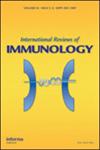behaperet病遗传学的全面综述。
IF 2.9
4区 医学
Q2 IMMUNOLOGY
International Reviews of Immunology
Pub Date : 2022-01-01
Epub Date: 2020-12-01
DOI:10.1080/08830185.2020.1851372
引用次数: 8
摘要
behet病(BD)是一种全身性炎症性疾病,主要表现为复发性口腔和生殖器溃疡、眼部受累和皮肤病变。虽然双相障碍的确切发病机制尚不清楚,但大量研究表明遗传因素是疾病易感性的关键因素。在丝绸之路沿线国家,人类白细胞抗原(HLA)-B51被报道为双相障碍最强的遗传相关因素。全基因组关联研究、当地遗传多态性研究以及土耳其、伊朗和日本人群的综合数据荟萃分析也发现了与双相障碍的新的遗传关联。其中,HLA- b *15、HLA- b *27、HLA- b *57和HLA- a *26等HLA等位基因也被发现是双相障碍的独立危险因素。而HLA-B*49和HLA-A*03是独立的BD保护性等位基因。此外,其他与BD易感性相关的基因也达到了全基因组显著水平,包括IL10、IL23R-IL12RB2、IL12A、CCR1-CCR3、STAT4、TNFAIP3、ERAP1、KLRC4和FUT2。此外,一些罕见的TLR4、IL23R、NOD2和MEFV基因的非同义变异也被报道参与了双相障碍的发病机制。根据MHC区域外基因座中参与宿主防御、免疫和炎症途径的遗传决定因素,提示对病原体的免疫反应是一个重要的环境因素,粘膜免疫是BD易感性的因素。本文章由计算机程序翻译,如有差异,请以英文原文为准。
A comprehensive overview on the genetics of Behçet's disease.
Abstract Behçet's disease (BD) is a systemic and inflammatory disease, characterized mainly by recurrent oral and genital ulcers, eye involvement, and skin lesions. Although the exact etiopathogenesis of BD remains unrevealed, a bulk of studies have implicated the genetic contributing factors as critical players in disease predisposition. In countries along the Silk Road, human leukocyte antigen (HLA)-B51 has been reported as the strongest genetically associated factor for BD. Genome-wide association studies, local genetic polymorphism studies, and meta-analysis of combined data from Turkish, Iranian, and Japanese populations have also identified new genetic associations with BD. Among these, other HLA alleles such as HLA-B*15, HLA-B*27, HLA-B*57, and HLA-A*26 have been found as independent risk factors for BD, whereas HLA-B*49 and HLA-A*03 are independent protective alleles for BD. Moreover, other genes have also reached the genome-wide significance level of association with BD susceptibility, including IL10, IL23R-IL12RB2, IL12A, CCR1-CCR3, STAT4, TNFAIP3, ERAP1, KLRC4, and FUT2. Also, several rare nonsynonymous variants in TLR4, IL23R, NOD2, and MEFV genes have been reported to be involved in BD pathogenesis. According to genetic determinants in the loci outside the MHC region that are contributed to the host defense, immunity, and inflammation pathways, it is suggested that immune responses to the pathogen as an important environmental factor and mucosal immunity contribute to BD susceptibility.
求助全文
通过发布文献求助,成功后即可免费获取论文全文。
去求助
来源期刊
CiteScore
11.00
自引率
4.00%
发文量
24
期刊介绍:
This review journal provides the most current information on basic and translational research in immunology and related fields. In addition to invited reviews, the journal accepts for publication articles and editorials on relevant topics proposed by contributors. Each issue of International Reviews of Immunology contains both solicited and unsolicited review articles, editorials, and ''In-this-Issue'' highlights. The journal also hosts reviews that position the authors'' original work relative to advances in a given field, bridging the gap between annual reviews and the original research articles.
This review series is relevant to all immunologists, molecular biologists, microbiologists, translational scientists, industry researchers, and physicians who work in basic and clinical immunology, inflammatory and allergic diseases, vaccines, and additional topics relevant to medical research and drug development that connect immunology to disciplines such as oncology, cardiovascular disease, and metabolic disorders.
Covered in International Reviews of Immunology: Basic and developmental immunology (innate and adaptive immunity; inflammation; and tumor and microbial immunology); Clinical research (mechanisms of disease in man pertaining to infectious diseases, autoimmunity, allergy, oncology / immunology); and Translational research (relevant to biomarkers, diagnostics, vaccines, and drug development).

 求助内容:
求助内容: 应助结果提醒方式:
应助结果提醒方式:


